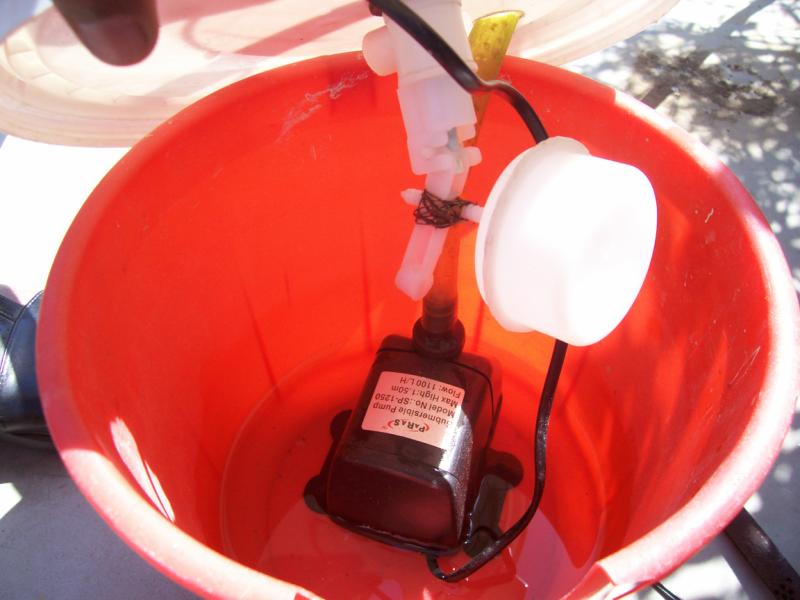Automatic watering system in flower pots, short-circuit alarm, GSM based burglar alarm and others
Automatic watering system in flower pot
Many times we see plants and flowers in our garden getting wilted due to lack of timely watering. Gardening has been Abdul’s hobby for long. Having noticed the problem he made a sensor controlled device that automatically switches on and off a motor depending upon the moisture content in the pot.
The device is designed in such a way that when the moisture content in the soil gets below a preset value, the sensor gets activated and switches on the water pump. When the soil gets sufficiently watered, i.e. moisture goes above the preset value; the sensor switches off the motor. There are two LEDs, red and green, on the sensor box. The red coloured LED indicates water deficit whereas the green one indicates water sufficiency.
He had to face considerable financial problems while developing this device and had to make and break many prototypes. The cost of the final prototype came to around Rs. 600. He has applied for patent through NIF[i]. He wants to modify the device by doing away with the motor and incorporating a magnetic system. He is still working on the concept. NIF assisted him for the development of this prototype along with a few other innovations.
Short-circuit alarm
Many a times, in the newspaper, Abdul found news about people’s death due to electrocution by touching a faulty device. Abdul used to wonder if he could do something about it. He realised that such deaths were mainly due to short-circuits. These, sometimes, result in electric shocks to the user and could even lead to fire in some cases.
He thought of a device that could alert the user if he had inserted a faulty device into a power plug or if there is some internal short-circuit. This device consists of a transformer, diodes, capacitor, an alarm, LED, one switch and one socket for output supply. In the first version, he had used Miniature Circuit Breaker (MCB) but that increased the cost, so in the second design he did not use it. The first design also had a fire alarm, which was removed in the second one. The device weighs 400g and is put near the main electricity board. One wire is connected to the meter while the other is earthed. When a faulty appliance with a short circuit is connected to any socket in the house, the alarm goes on. Once the appliance is unplugged, the alarm automatically goes off. This device works only in cases of appliances where earth wire is given (i.e. appliances that have three-pin plugs).
It took him around six months to develop the device and cost him Rs. 700. He estimates, now the same would cost only Rs 300.
GSM based burglar informer
This is a system to inform about attempted break in the house when owners are away.. In this device, there is a leaf switch on the main door. When door is forcibly opened, a relay switch is triggered, which activates the circuit. The GSM system attached to the circuit then dials a preset mobile number. It continues the dialing until either the system is switched off or the user of the preset mobile number accepts the call. The system can be switched on and off as per the requirements. It can be used in houses, offices, shops and even in a vehicle.
Presently, Abdul has used a cardboard box to fit the assembly, which took him three months (and the sacrifice of two mobile sets) to complete. Excluding the mobile cost, the system costs Rs. 1500.
Ceramic pot with heating filament
At a cost of Rs. 50, Abdul has incorporated an electrical heating filament in a ceramic pot, which can be used to burn slowly, small mosquito coil fragments/tablets, dry neem leaves, havan samagri of the Hindus or even loban used by Muslims. After burning, the ash and the residue can be easily disposed by inverting the pot. The whole process, thus, remains very clean.
Automatic water pump controller
Abdul Kaleem has developed a water pump operating system, costing about Rs1000 to manage the filling of overhead tanks in houses and buildings. The device can start on its own and control the filling of the tank. The device switches off the pump when the tank gets filled. Similar systems of course already exist in the market.
Automatic flood alert using GSM
Abdul has developed a flood alert model. Noticing that flash floods often result in great loss of life, property and livestock, he decided to make this model. In this model, there would be a GSM based transmitting tower in the river with sensors at different heights. Complementarily, there would be similar receiving towers in nearby villages. As and when the water level rises in the river, the sensors at different heights pick up the rise and transmit signals to the receiving towers in different villages. The degree of water rise can then be indicated by the receiving towers by means of lights or alarms. Abdul has used lights of three different colours for the same.
His mother says that he takes a lot of interest in doing such things and even forgets having his food when he is absorbed in some serious thought/work. He is very frugal in his approach and tries to collect all his requirements first from the waste materials available with him or his friends. It is only in extreme cases, when some things are not available anywhere, he purchases it from the market. He wants to open a science club to promote scientific thinking among people. His friends and family have been generally supportive of him but there are many others who have made fun of him. To such detractors, he wishes to say
Yadi koi samanya vyakti koi naya aviskar karta hai to samaj ke achhe logon ko us vyakti ki kalpana aur navnirman ko protsahan dena chahiye. Use hatotsahit nahi karana chahiye.
(If a common man has come up with something useful, people of the society should appreciate the imagination and creativity of the innovator rather than demotivating him)
[i] The concept of automatically watering plants is available in art however, prior art discloses multifarious approaches for the same. US patent 3758987 discloses an automatic plant watering device, which includes a porous sensing device that functions as an air valve and responds to the moisture condition of soil to control a water supply. US patent 6128856 discloses an automatic watering pot for dispensing water into the soil at or below the root level of a potted plant. The device has a bottle, which serves as a water reservoir, a cap for the bottle having a rotary valve, a delivery tube inserted into the cap, and a dispersion fitting at the free end of the delivery tube. The automatic watering device is disposed with the bottle inverted above the level of the soil, the delivery tube extending into the soil, and the dispersion fitting to a depth equal to or below the level of the roots. The dispersion fitting has a plurality of pinhole orifices, which serve to provide a path for water to flow from the tube into the soil, for air to enter the tube and as a filter to prevent the soil particle from entering the bottle. US patent 20020024445 discloses a flower container having a control unit comprising a water sensor for directly or indirectly detecting water content in soil in a flower pot, a memory and a speaker. When receiving detection signal from the water sensor which indicates that the water content is decreased to below a predetermined level, the message is read out from the memory and outputted through the speaker to urge the user to supply water. US patent 20080190020 discloses a plant watering system comprising a sensor buried in the soil in the root region of plant, the sensor passing a low voltage current through the soil to measure the moisture content of the soil and with the sensor being switched on and off in a pulse like manner. The detected moisture level is processed by the system and water supplied to the plant when said moisture level is below a predetermined moisture level for that particular plant or groups of plant. US patent 4885869 discloses an automatic water- supplying flowerpot and its water supply control method in which a principal of capillary action is utilized. The URL http://images.businessweek.com/ss/05/06/idea2005/source/48.htm discloses a self-watering flowerpot in which a wick is placed in the holes of a ceramic flowerpot. The plant is placed in the pot, which is then placed on top of a glass container filled with water. The wick dangles into the container and the plant can then take up the necessary amount of water through the wick.
“Chhamtaon ka vikas vyakti ko pratibhawan banata hai. Iske liye gyan, dhairya tatha sahayog awashyak hai”
‘Development of capabilities makes a person talented and for it one needs to have knowledge, patience, and the support of people’.
A young man from Deoria, Abdul Kaleem (24), is a serial innovator. He has developed a number of innovative projects, interesting among those are automatic watering system in flower pots, short-circuit alarm, GSM based burglar alarm, overhead tank monitoring and regulating system.
After graduating in arts in 2007 from Gorakhpur, he is contractually associated with Non-conventional Energy Development Agency (NEDA) in a project related to a street light controller device. He was still a student when his entry was received by NIF for fifth campaign.
He comes from a well educated background. His father is a teacher and all his four elder siblings are educated, married and settled while the two younger brothers are still studying. Theirs is a joint family staying together in a two floor house. His father also has little less than half hectare land where he cultivates sugarcane, rice, wheat, gram, mustard, maize, pulses etc., as per need. Abdul performed average in studies but took interest in electrical/electronics since childhood. Due to his habit of experimentation, he was often punished for messing things up.. Many a times, he was reprimanded for wasting time. Though, mostly he used scrap articles but at times he even spent his pocket money to purchase different items from the market. At other times, he had to do an odd job or two for some extra money. His friends sometimes used to tell him that such things would not take him anywhere. But, nothing could deter him from doing the things that he liked. His elder sister and her husband, his class teacher and one of his friends always encouraged and supported him to do better.
He once read about NIF in a local newspaper and through a correspondent got the address. The thing that appealed to him the most was that such an organisation was there to support grassroots innovators like him. His creative pursuits have been covered well by local electronic and print media during the last two years. He was also given theNav-anveshak Samman in February 2009, by the Uttar Pradesh government, for his efforts in promoting science and technology through his work.
Complete Specification Filed , 1316/KOL/2009








